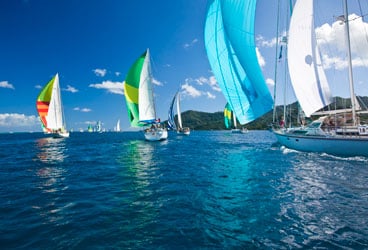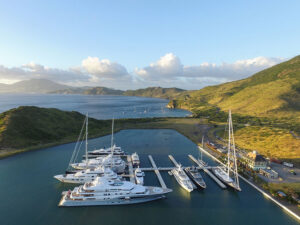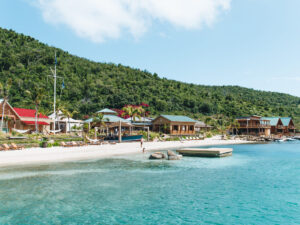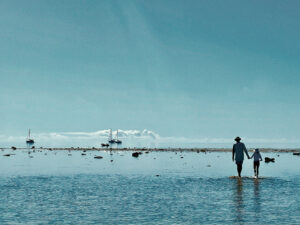
Society Islands
Everything begins at Taputapuatea. It was from the nearby pass through the fringing reef that the legendary voyages of a millennium ago were launched, the voyages of migration that populated the Austral Islands, the Hawai’ian Islands, even New Zealand. It’s the mythical birthplace of the god Oro, and still today you’ll find stones from this marae in the most sacred sites all across Oceania. This is the center of the Polynesian world. The wide Pacific itself pivots here, its tides rising and falling with a metronomic regularity, 12 o’clock and 6 o’clock, 12 and 6, every day of every year.
“Regarde,” says Pauline, who’s showing me through the outdoor temple on an afternoon of warm tropical rain. “Tu sais ce que c’est? C’est l’arbre à pain.”
Struggling through my schoolboy French to keep up with her, I’m a little slow on the uptake. But a moment later, it dawns on me what she’s just said.
Breadfruit!
With that word in my ears and the broad leaf in my hand, all 30-odd years of reading and dreaming about this place come flooding in: James Cook plotting the transit of Venus; the navigator-priest Tupaia drawing accurate maps of the islands hundreds of miles out; Roger Byam and Fletcher Christian shaking hands on the beach before the Bounty sailed off forever; Bernard Moitessier abandoning Europe and publicity to save his soul; Paul Gaugin; Alberto Torroba; Jacques Brel—the list goes on. For, truly, in a lifetime of traveling and imagining places, no other spot on the planet has had the same pull on me as this one.
Here it was: Tahiti.
The Lay of the Land
I’ve come this week to sail in the seventh running of the Tahiti Pearl Regatta, an annual five-day tour of the Society Islands whose spirit, in the words of its organizers, “is to blend sport, culture, and entertainment.” And how. This May 2010 event coincides with the arrival of the World ARC, two dozen international boats engaged in a 15-month circumnavigation. Together with the other 50-some boats in the regatta—mostly local sailors, but also charterers who, like me, have flown in—the World ARC crews gather each night on the beach to listen to the ecstatic harmonies of the local singers, dance the tamure, and feast on chicken and fish and all manner of local fare roasted underground in banana leaves and coconut milk. It’s almost too good.
I’m sailing aboard the crewed charter yacht Milena, a Lagoon 570 catamaran, with hosts Didier Alphen and Pauline Barbat, as well as a film crew from Time Warner Cable who come to be known throughout the fleet as “the CNN guys.” They’re not sailors, the CNN guys, but they’re absolutely game. Their on-air reporter, Ben McCain, is a big-hearted and gregarious West Texan who greets all comers with a loud “Buongiorno!” and who spends much of his off-camera time scripting the South Seas sequel to his campy thriller Killer Tumbleweeds. It’s quickly clear that we’re going to have a fine time together. Plus, any initial cultural differences among us are quickly swept away as Didier brings up the one cultural ambassador we all hold in common. Yes, just a few weeks before our arrival, Jimmy Buffett came to play a fundraiser at Bloody Mary’s on Bora-Bora—reportedly his first show there since recording One Particular Harbour 28 years ago. Buffett is an avid fly fisherman, and in these parts Didier is known as the master of that art. And so it was that Buffett and his entourage had spent their downtime aboard the boat we were now sailing. And so it was that we now spent an idyllic afternoon passage to Bora-Bora listening to music from a CD warmly inscribed to Didier and Pauline by the Head Parrothead himself.
When Didier Alphen came to these islands from France, he thought he’d stay a year. Twelve years later, he doesn’t look like a man who’s about to leave soon. He’s sailed in plenty of other places: the Caribbean, the Med, elsewhere in the Pacific. But this place clearly has a hold on him. “You have a big mix of everything here,” he says. “The safety is fantastic—no pirates—and the people are so welcoming and warm. The sun is there all the time. Pristine waters. I mean, it could be worse!” I very quickly come to appreciate his and Pauline’s deep knowledge and love for these islands and their people.
Speaking of these islands, we should take a moment to say what we mean when we say Tahiti—a name that’s used in both a diffused and a particular sense. Strictly speaking, Tahiti is one island in the Îles du Vent, or windward, chain of French Polynesia’s Society Islands archipelago. Its capital, Papeete (pronounced pa-peh-AY-tay), is the commercial and political hub for all of French Polynesia, which stretches across 100,000 square miles of ocean from the Marquesas and the Tuamotus north of us all the way to Easter Island to the south. Papeete, with its urban population of more than 130,000 and a network of highways, businesses, and billboards, feels like a modern European city with palm trees.
Most of us, when we think of Tahiti, are thinking of something different, something we’re more likely to find about 120 miles west of Papeete in the Society Islands’ Îles Sous le Vent, or leeward chain. These islands are Raiatea, Tahaa, Huahine, and Bora-Bora. Raiatea (pronounced rah-ee-ah-TAY-ah) is the de facto sailing capital of Tahiti. The principle boatyards, chandleries, and charter bases are all concentrated here. And it’s among these slower-paced islands that the Tahiti Pearl Regatta sails. Our itinerary—from Raiatea to Bora-Bora and back, then once around Tahaa—gives us a fine introduction to the Polynesian leeward islands.
An Amphidromic Point
We aboard Milena are observers of the racing, not participants, and so we have the leisure on the first day of racing to pull out ahead and watch the lagoon billow with spinnakers of yellow, pink, blue, and green by the dozens under the brooding backdrop of Raiatea’s Mount Tapioi. The fleet meanders across the lagoon toward Tahaa on a morning of light southeasterlies, then aims north toward Passe Papai and out into the open Pacific.
It leaves us plenty of time to talk. Ben asks why these islands hold such a particular allure with sailors.
“The Societies are middle-aged,” Didier says. Pressed, he replies that by contrast, the Marquesas are young islands. “They’re volcanic,” he says, “but they have no reef.” The Tuamotus? “They’re old. They have only a reef but no volcanic island.” What the Societies offer is the perfect moderate blend of high mountains and fringing reef with a wide lagoon in which to fish and sail and anchor safely. To hear Didier tell it, you get the sense that the islands themselves are growing and aging and dying—even voyaging across the Pacific. “They sink and drift three centimeters every year,” he says. “It’s a lot.”
An earlier conversation with regatta organizer Stephanie Betz touched on another of the local charms for sailors. “In the Society Islands, we have something very particular. We’re sitting at an amphidromic point.”
Amphi-what?
“Donnes-moi une bouteille,” she says to Didier. Stephanie invites us to imagine that the half-filled water bottle is the whole South Pacific Ocean, with Australia at one end and South America at the other. She holds the bottle on its side, then gently tips it back and forth. “When the tide is high in Australia, it’s low in South America, and so on,” she says. “We’re exactly in the middle. It means that we aren’t affected by the moon tide. The tide here in the Society Islands is always high at midnight and noon, and low at 6 a.m. and 6 p.m. Every day of the year.” Whereas powerful tidal currents run through the Tuamotus and other archipelagos, here there’s just a gentle rise and fall of several inches at the same time every day and very little current.
But mere geology and tides don’t explain the magic of the place. “I speak a lot of Tahitian,” Didier says, “but it’s very difficult to translate Tahitian into French. Tahitians speak in pictures.”
Didier tells of waking up in the wee hours and seeing all the Tahitian men going out in their boats, and even now, after a decade of living among them, he still has no idea what compels them into their boats on one day and not another. Hours later, they come back loaded down with fish. “They can teach you many things,” says the master fisherman, recognizing full well that he still has an awful lot of things to learn about fish and the sea.
These are the things we talk about as we reach across the long and gentle north-running Pacific swells between Tahaa and Bora-Bora. And later that night on a motu out near the reef, we taste for ourselves the overwhelming hospitality of the people among whom Didier has spent the last happy decade.
Score One for the Good Guys
“We haven’t tacked this much since we left the Caribbean,” says Rosemary Thomas from Crazy Horse, a Sundeer 60 out of Maryland that’s sailing in the World ARC.
Her husband, Bill, chuckles. “It’s true,” he says. “We’ve been on port tack ever since we left Ecuador.”
I’ve joined Rosemary and Bill and their 26-year-old son, Matt, for the second day of racing, Bora-Bora back to Tahaa. Ahead of us is the pass back into the lagoon and the finish line for the day’s course. We have a 51-foot Beneteau in our sights—it’s the charter boat Napé. And we’re pretty sure we’ve got them. We’re making trees, as they say. Banana trees. Pandanus trees.
But what we aboard Crazy Horse lack—three American sailors halfway toward becoming circumnavigators, plus me just in from New England—is a local rock pilot: someone who understands how water moves around these islands. And so we place our bet on the inshore course, right in alongside the reef, where it seems the boats out in front are doing better. Napé splits from us, heading offshore. We sail in as close as we’re comfortable, then tack back out.
Alas, when we cross, Napé’s wake demonstrates just how poor our bet was. Both boats harden up for the final leg with half a mile to go. Still, there’s hope for us. We seem to be reeling them back in. And so it goes for several minutes, as the surf begins to thunder on the reef on both sides around us, but then—what’s this?—the orange racing buoy disappears. With one eye on the frothing reef to leeward and one eye on the committee boat, we struggle to figure out what’s happening. I go for the racing rules.
Under time limits, I find this helpful note: DO = (D/VT X 1.2) – TR.
Huh?
Then I recall something Stephanie said at the outset about the president of the Tahitian Sailing Federation. “If the wind is particular, he could change the rules.”
Indeed, it seems the wind today was particular. Yes, after a full day of racing and just moments before entering the pass, that’s it. Race over.
It wasn’t a terrible result in the end—just squishy enough to admit multiple good-natured arguments that night at the party at a motu off Tahaa’s eastern shore. Mostly, it was fun to talk to Napé’s John and Jan Cook about all the places they’d chartered in the five years they’ve owned a Moorings charter boat in the Caribbean. As part of the yacht-ownership agreement, owners can exchange time on their own boat for similar boats in other Moorings locations. For this French Polynesia charter, with their sons and a couple of friends, the Cooks stayed for two weeks, the first of which coincided with the regatta. For the second week, they spent a more leisurely time exploring Huahine and Tahaa.
I spoke to Jan again last February. “We loved chartering in Polynesia,” she said. “And our time in the regatta was so much fun. It was a great way to see and experience the culture of the various islands and to just meet other people. And with all those ARC people that were sailing around the world, it really opened our eyes to a whole different thing that we don’t usually get on a charter.”
Opened their eyes? It sure seems that way. Their boat is about to come out of charter. And as Jan told me: “Just this weekend, John even said, ‘I’d like to sail over to Tahiti.’”
As for the rest of us cruisers, our kind was vindicated when the overall winners of the 2010 Tahiti Pearl Regata were announced on the event’s final day. When all was said and done, who won? Was it one of the crackerjack local members of the Tahitian Sailing Federation? Was it one of the two fully outfitted crews who flew in from St. Tropez?
Nope and nope. The overall winners of the 2010 Tahiti Pearl Regatta were the cruisers Srecko and Olga Pust of Slovenia, a husband and a wife sailing their Sweden Yacht 45 Ciao in full cruising trim. They were just passing through these lovely islands on their way to Tonga and Bali and South Africa and Brazil and, finally, St. Lucia at the conclusion of the 2010-2011 World ARC rally.
In the meantime, we all came away feeling lucky to have shared each other’s company for a brief sojourn among the beautiful, the moderate, the magic Society Islands.
Tim Murphy, a Cruising World_ editor at large, is an independent writer and editor based in Portsmouth, Rhode Island._








